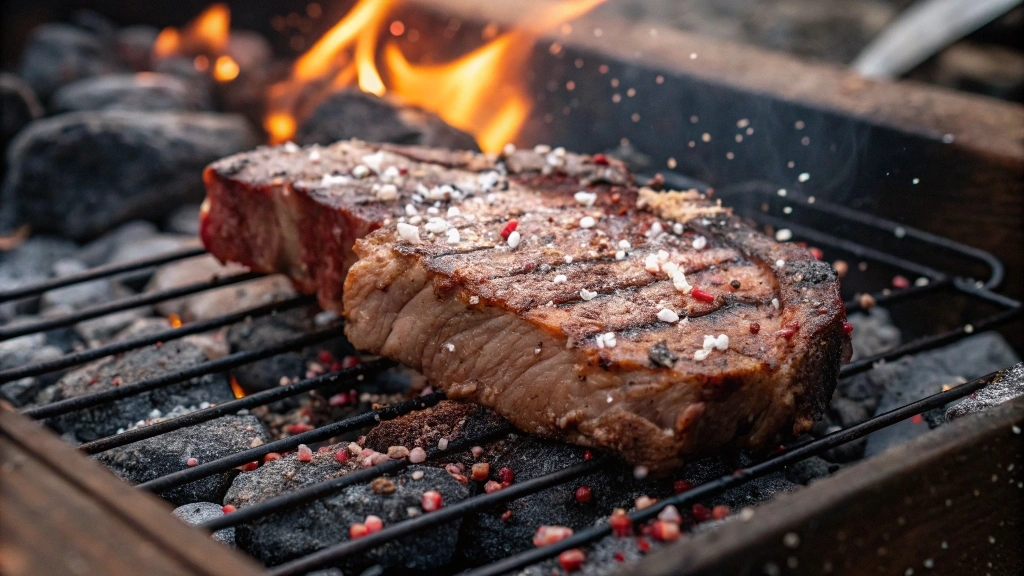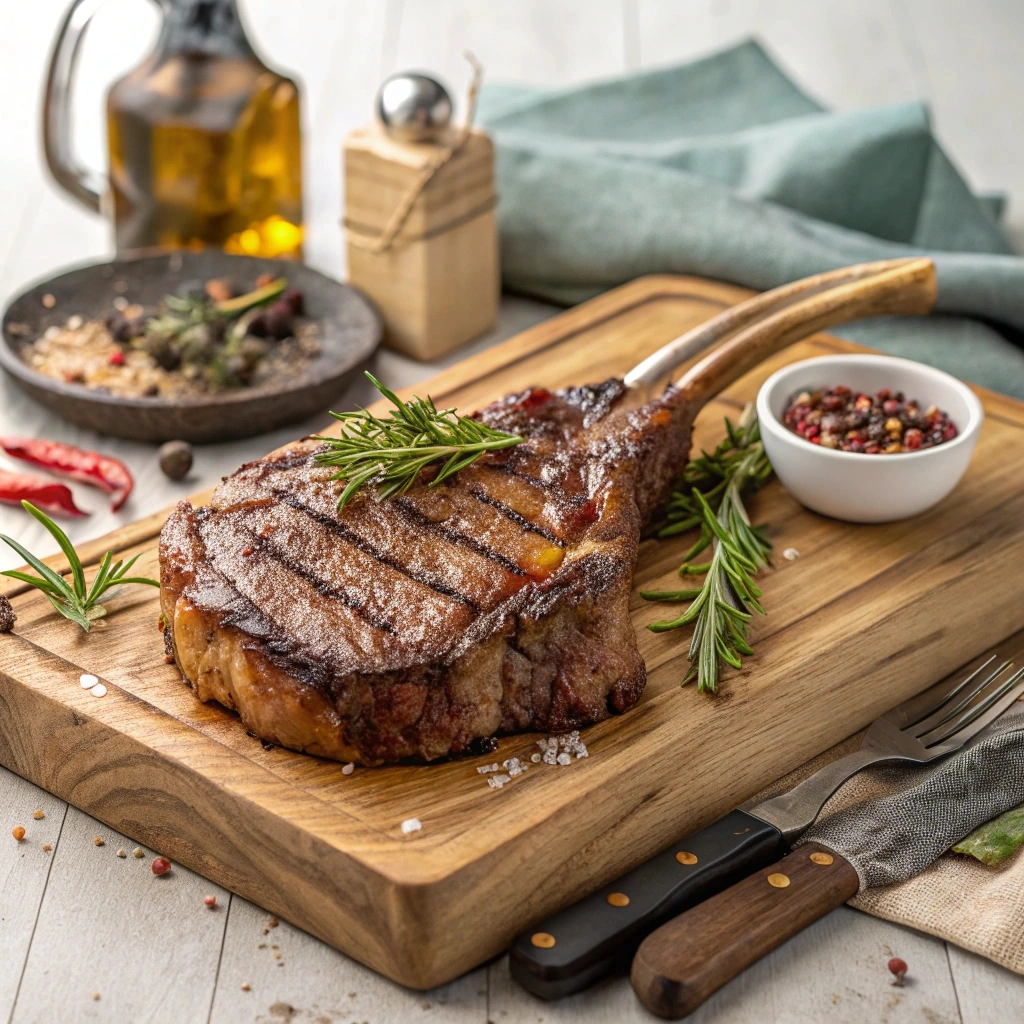Steak lovers, rejoice! The cowboy steak is here to revolutionize your grilling game. This thick, bone-in ribeye cut is not only a feast for the taste buds but also a showstopper in presentation. From its juicy marbling to its tender texture, the cowboy steak exudes luxury and flavor. But what sets it apart? Why is it so expensive? How do you cook it to perfection? This guide dives deep into everything you need to know about this iconic cut of beef, offering tips, comparisons, recipes, and even fun facts. Whether you’re a grilling pro or just exploring high-end cuts, we’ve got you covered. Let’s saddle up and dig in!
What is a Cowboy Steak?
Definition and Characteristics of Cowboy Steak
The cowboy steak is a thick, bone-in ribeye with a bold personality. Its signature feature is the “frenched” bone, where a portion of the rib bone is cleaned to enhance its dramatic look. This cut usually comes 2–2.5 inches thick, making it ideal for hearty eaters and steak connoisseurs alike. The rich marbling throughout ensures every bite is tender, flavorful, and unforgettable.

This cut is popular in upscale steakhouses and among grill enthusiasts because it combines luxury with tradition. Whether you’re planning a family barbecue or a fancy dinner, a cowboy steak is sure to impress.
Origins and History
Why the name “cowboy steak”? Its roots trace back to the American frontier days, where cowboys enjoyed hearty meals cooked over open flames. The ruggedness and substantial size of this steak embodied their robust lifestyle. It’s no surprise this cut became synonymous with hearty, outdoor meals, perfect for a campfire or grill.
Over time, it gained popularity not only for its flavor but also for its visual appeal, especially when served at high-end dining establishments. The bone-in ribeye has become a symbol of indulgence and culinary craftsmanship.
Cowboy Steak vs. Tomahawk Steak
Key Differences
Although both cuts are visually stunning and packed with flavor, the bone-in ribeye and tomahawk steak have distinct characteristics. A rib steak with a shorter frenched bone, typically around 2–3 inches in length, is often referred to as the cowboy cut. In contrast, the tomahawk steak features an extended bone, sometimes up to 10 inches, giving it the appearance of a hatchet handle — hence the name.
The bone’s length doesn’t affect the taste but significantly alters the steak’s presentation. The tomahawk steak’s dramatic look makes it a favorite for special occasions, while the cowboy steak is perfect for everyday indulgence without losing its flair.
Which Cut is Better for You?
Choosing between the two often boils down to your preference and the occasion. If you’re hosting a backyard barbecue and want to wow your guests, the tomahawk steak’s impressive size and appearance might be the way to go. However, the cowboy steak offers the same rich marbling and robust flavor in a more manageable size, making it an excellent choice for family dinners or intimate gatherings.
Additionally, the cowboy steak is typically more affordable than its tomahawk counterpart, making it an appealing option for steak lovers who want premium quality without breaking the bank. For more on choosing steak cuts, check out Chuck Steak Recipes and Tips to explore other flavorful options.
Why is Cowboy Steak So Expensive?
Premium Cuts and Butchering
The cowboy steak comes from the rib section of the cow, one of the most sought-after parts for its tenderness and marbling. The meticulous frenching process, which involves cleaning the bone to enhance its presentation, requires time and skill, adding to the cut’s overall cost.
Moreover, the bone-in ribeye inherently yields a luxurious texture and taste due to its marbled fat. This fat not only adds flavor but also keeps the meat moist during cooking, making every bite melt in your mouth.
Market Demand and Rarity
This cut of beef isn’t as commonly available as options like sirloin or strip steak. Its exclusivity, paired with high demand among steak aficionados, significantly contributes to its premium price. With more people seeking this show-stopping option for its unmatched flavor and presentation, demand often surpasses supply, leading to a higher cost.
Investing in a cowboy steak ensures a memorable dining experience, especially for special occasions. For cost-effective alternatives, you might explore other beef options such as steak pasta pairings in dishes like Steak Pasta, which deliver rich flavors at a fraction of the cost.
How to Cook Cowboy Steak
Preparing the Steak

To cook a perfect cowboy steak, preparation is key. Start by selecting a steak with even marbling and a fresh, vibrant color. Let the steak sit at room temperature for 30–60 minutes before cooking; this ensures even cooking throughout. Generously season all sides with kosher salt and freshly ground black pepper. For added flavor, you can rub the steak with garlic, rosemary, or a drizzle of olive oil.
Proper seasoning enhances the natural taste of this premium cut of beef without overshadowing its rich, bold flavor. Whether you choose to grill or sear, beginning with a well-prepared steak lays the groundwork for a dish worthy of any fine dining experience.
Cooking Methods for Cowboy Steak
Grilling
Grilling is one of the best ways to bring out the cowboy steak’s smoky and charred flavors. Preheat your grill to medium-high heat, creating zones for direct and indirect heat. Sear the steak over direct heat for about 3–5 minutes on each side to form a crust. Then, move it to indirect heat and close the lid, allowing it to cook slowly until it reaches your desired doneness.
Pan-Searing
For an indoor option, use a cast-iron skillet to achieve a golden crust. Heat the skillet over medium-high heat, add a high-smoke-point oil, and sear the steak for about 4–5 minutes on each side. Finish it in a preheated oven at 375°F for 8–10 minutes to ensure it cooks evenly.
Cooking Time and Doneness Levels
Use a meat thermometer to check doneness:
- Rare: 120°F
- Medium-Rare: 130°F
- Medium: 140°F
Let the steak rest for 5–10 minutes after cooking to allow the juices to redistribute, making every bite succulent and flavorful.
Cowboy Steak Recipes and Pairings
Classic Cowboy Steak Recipes
One of the most popular ways to enjoy a cowboy steak is with a simple compound butter topping. Mix softened butter with garlic, parsley, and a hint of lemon juice to complement the steak’s robust flavor.
For a more adventurous option, try marinating the steak in soy sauce, garlic, and a splash of red wine for a savory and slightly sweet profile. Once grilled to perfection, the cowboy steak can be paired with sautéed mushrooms or caramelized onions for an elevated dining experience.
Perfect Sides and Drinks
Pairing a cowboy steak with the right sides is just as important as the preparation. Creamy mashed potatoes, roasted asparagus, or a fresh Caesar salad are classic companions. If you’re looking for a carb-light option, consider grilled zucchini or a simple herb vinaigrette drizzle over arugula.
As for drinks, a bold red wine like Cabernet Sauvignon enhances the steak’s richness, while craft beers with smoky undertones complement its grilled flavors beautifully.
For more delicious dinner ideas, check out our article on Chuck Steak Recipes and Tips for inspiration on different cuts and preparations.
FAQs About Cowboy Steak
What Cut of Meat is Cowboy Steak?
The cowboy steak is essentially a bone-in ribeye, with a large portion of the rib bone left intact. This bone is “frenched,” meaning it’s cleaned for a refined presentation. Known for its generous marbling, this cut is exceptionally juicy and flavorful, making it a favorite among steak enthusiasts.
Its size, thickness, and rich flavor profile make it a standout on the grill or at a high-end steakhouse. If you’re seeking a steak that combines tenderness with a bold, beefy taste, this bone-in ribeye cut is a top-tier choice.
What’s the Difference Between a Tomahawk and a Cowboy Steak?
While both cuts come from the rib section, the main difference lies in the bone’s length. A tomahawk steak features a much longer bone, resembling a hatchet, which enhances its dramatic presentation. The cowboy steak, on the other hand, has a shorter bone, making it slightly more compact and easier to handle.
Both cuts are rich in flavor, thanks to their marbling, but the tomahawk steak is often chosen for its visual appeal at special events. The cowboy steak offers the same mouthwatering flavor with a more manageable size, perfect for everyday indulgence.
Why is Cowboy Steak So Expensive?
The cowboy steak’s price reflects its premium quality. It’s cut from one of the most sought-after sections of the cow, offering unparalleled tenderness and marbling. The labor-intensive process of frenching the bone also adds to the cost.
Moreover, the demand for bone-in cuts like the cowboy steak often exceeds the supply, further driving up its value. But rest assured, every penny spent on this luxurious steak is worth it for the flavor and experience.
How to Cook Cowboy Steak?
Cooking this bone-in ribeye cut requires a balance of high heat for searing and moderate temperatures for even cooking. Whether you enjoy the smoky flavor from grilling or the crust from pan-searing, a meat thermometer is essential to get the perfect doneness. Remember to let the steak rest after cooking; this step locks in the flavorful juices, ensuring every bite is tender and delicious.
Health and Nutrition Facts
Nutritional Value
A cowboy steak is not just delicious but also packed with essential nutrients. Each serving is rich in protein, which supports muscle health and energy. It also contains iron, zinc, and B vitamins, making it a great option for those looking to boost their daily nutrient intake.
However, due to its marbling, the cowboy steak is higher in fat compared to leaner cuts. Moderation is key to enjoying this indulgence while maintaining a balanced diet. Pairing it with fresh vegetables can help balance your meal.
Balanced Diet Tips
While the cowboy steak is undeniably a treat, complementing it with healthy sides can elevate its nutritional value. Consider roasted vegetables, a light salad, or quinoa as accompaniments. These sides not only enhance the meal’s flavors but also add fiber and other essential nutrients.
For more insights into balancing rich flavors with healthy sides, explore our guide to Healthy Quiche Recipe Tips. It’s filled with great ideas for nutritious pairings that keep indulgence guilt-free.
Fun Facts About Cowboy Steak
Cultural Significance and Popularity
The cowboy steak is more than just a meal—it’s a symbol of rugged, Western charm. Its name pays homage to the hearty meals enjoyed by cowboys after long days on the range. Whether served at a steakhouse or grilled over an open flame, this cut embodies indulgence and celebration.
In modern culinary culture, the cowboy steak has gained fame for its dramatic presentation and rich flavor. It’s a staple on menus at high-end steakhouses and a favorite among grill enthusiasts looking to showcase their skills.
Interesting Facts About Ribeye Cuts
Did you know the ribeye is considered one of the most flavorful cuts of beef? The cowboy steak, being a bone-in ribeye, retains even more flavor thanks to the marrow within the bone. Chefs often say that cooking meat with the bone enhances its taste, making this cut stand out even more.
Additionally, the term “frenching” refers to the careful cleaning of the rib bone, a technique borrowed from fine dining traditions. This attention to detail transforms the steak into a culinary masterpiece, perfect for impressing dinner guests or simply savoring on your own.
FAQs from “People Also Ask”
What Cut of Meat is Cowboy Steak?
The cowboy steak is a bone-in ribeye, prized for its marbling and tenderness. It’s thick-cut, often measuring over two inches, with a frenched rib bone that adds to its visual appeal.
What’s the Difference Between a Tomahawk and a Cowboy Steak?
The main distinction lies in the bone length. The tomahawk steak has a longer, more dramatic bone, while the cowboy steak offers the same flavor in a slightly more compact form.
Why is Cowboy Steak So Expensive?
The cowboy steak’s cost reflects its premium quality, marbling, and the labor involved in frenching the bone. Its limited availability and high demand also contribute to its price.
How to Cook Cowboy Steak?
Cooking a cowboy steak involves a hot sear followed by slower cooking to reach the desired doneness. Grilling and pan-searing are popular methods, with resting time being essential for the best flavor.
Conclusion
The bone-in ribeye is more than just a meal—it’s a true experience for steak enthusiasts and casual food lovers alike. Its rich marbling, bold flavor, and impressive presentation make it a centerpiece on any table. Whether grilled to perfection or seared in a cast-iron skillet, this premium cut offers unmatched tenderness and taste, embodying the luxury of high-quality beef.
While its price may reflect its high-end nature, the indulgence of a cowboy steak is worth every penny, especially for special occasions or a show-stopping dinner. By understanding its origins, cooking techniques, and ideal pairings, you can transform this cut into a culinary masterpiece.
Whether you’re savoring its Western roots or experimenting with recipes, the cowboy steak delivers a unique blend of history and flavor that keeps people coming back for more. Treat yourself and discover why this steak is a true classic!

